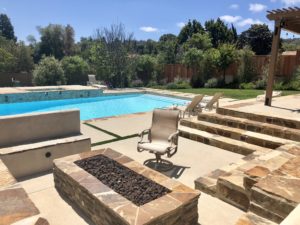In the world of home and garden, the concept of an “outdoor living space” has taken center stage. Homeowners are no longer content with just lawns to mow and decks to seal; they are now seeking to seamlessly extend the utility and functionality of their indoor spaces into the great outdoors.
This article explores the secrets to successfully crafting an outdoor living space that meets all your needs while also highlighting some common missteps to avoid.

The Dos
1. Consider The Usage
Before you can embark on creating your dream outdoor living space, it’s essential to envision what you want to achieve. Think of it as designing an indoor room but in the open air. Ask yourself:
- What will this space be used for? Entertaining, relaxation, or perhaps an outdoor kitchen or sports bar? Your purpose will influence decisions on location, features, privacy, and decor.
- Who will be using it? Kids, adults, pets, or a mix of all? Tailor the space to accommodate the intended users.
- How many people will typically gather here? Whether you host large gatherings or prefer intimate get-togethers, the size of the space should reflect your needs.
2. Incorporate Vertical Elements
Create a sense of enclosure and boundaries for your outdoor living space by incorporating vertical elements. Also, these elements could include hedges, trellises, curtains, or sliding doors, which can serve as effective substitutes if you can’t go the brick-and-mortar route.
3. Add Visual Interest and Enhance Atmosphere
Just like your favorite indoor spaces, your outdoor haven can benefit from visual interest. Thus, enhance the atmosphere with landscaping, furnishings, lighting, artwork, and decorations that align with your space’s layout and purpose. For instance:
- Introduce a fire feature like a fire pit or outdoor fireplace for warmth and gatherings.
- Incorporate a water feature, such as a fountain or waterfall, for relaxation and tranquility.
4. Choose the Right Location
Consider the sun’s path, prevailing winds, and privacy when selecting the location for your outdoor living space. You want to ensure comfort and functionality throughout the day.
5. Invest in Quality Furniture
Outdoor furniture should be durable and weather-resistant. Opt for materials like teak, aluminum, or weatherproof wicker, and invest in quality cushions and upholstery that can withstand the elements.
6. Create Shade
Install an awning, pergola, or patio umbrella to provide shade during hot summer days. This will make your outdoor space more comfortable and versatile.
7. Incorporate Greenery
Incorporate plants and landscaping elements to connect your outdoor space with nature. Potted plants, vertical gardens, and hanging baskets can add life and color to your outdoor oasis.
8. Lighting is Key
Extend the usability of your outdoor area into the evening by incorporating proper lighting. Use a combination of ambient, task, and accent lighting to create a cozy atmosphere.
9. Add Comfort
Invest in comfortable seating and accessories like outdoor rugs and throw pillows to make your space inviting and cozy.
The Don’ts
1. Neglect Your Surroundings
The environment surrounding your outdoor living space is pivotal in your planning. Pay close attention to factors like:
- Sun exposure
- Prevailing wind direction
- Sightlines, both outward for ambiance and inward for privacy
- The grade of the area—like indoor rooms, outdoor spaces should be built on a level surface
- Accessibility, especially if you’re planning an outdoor kitchen adjacent to your indoor one
2. Completely Close Yourself Off
While defining boundaries is essential, remember that too much closure can detract from the charm of your outdoor room. Maintain some degree of openness to allow natural light and fresh air to flow. Roof overhangs, pergolas, or shade structures strike a balance between shelter and breathability.
3. Overwhelm
Avoid overloading your space with too many features. If it’s a multipurpose area, consider visually dividing it with various surfaces, tiered sections, furniture arrangements, or structural elements like canopies. To add, thoughtful lighting placement and intensity can guide the use of your outdoor living space effectively.
4. Neglect Maintenance
Outdoor spaces require regular maintenance. Don’t forget to clean and store cushions during the off-season, and keep an eye on any needed repairs or replacements.
5. Forget About Privacy
Ensure your outdoor space provides a level of privacy that makes you feel comfortable. Further, consider using screens, trellises, or tall plants to create separation from neighbors or passersby.
6. Neglect the Climate
Be mindful of your local climate and weather conditions. Thus, don’t choose materials or furniture that can’t withstand your region’s specific weather patterns.
7. Skimp on Comfort
Outdoor living spaces should be just as comfortable as indoor ones. So, don’t compromise on comfort for the sake of aesthetics.
8. Ignore Personal Style
Your outdoor space should reflect your personal style and preferences. Hence, don’t blindly follow trends; instead, choose elements that resonate with you.
9. Neglect Safety
If you have children or pets, make sure your outdoor space is safe for them. Also, avoid sharp edges, secure heavy items, and consider safety gates or barriers if necessary.

Creating the perfect outdoor living space is about striking a balance between functionality and aesthetics while considering your unique needs and preferences. So, by following these dos and avoiding the don’ts, you can design an outdoor oasis that seamlessly integrates with your indoor spaces and enhances your overall quality of life. Whether you seek relaxation, entertainment, or a blend of both, your outdoor living space can become a cherished extension of your home, providing endless opportunities to enjoy the great outdoors.
Explore Revamp Your Yard With A Backyard Makeover for more inspirational ideas.


